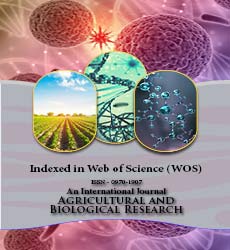Agricultural and Biological Research
RNI # 24/103/2012-R1
A. Vinothini and S. Iruthaya Kalai Selvam*
Background: Root-knot nematode Meloidogyne incognita represents one of the most significant genera of plant-parasitic nematodes on various crops, as it is widespread and poses a threat to thousands of plant species. As a result of their infection of the root system, which absorbs water and nutrients, the entire plant is harmed. Their population expands at a quick rate as a result of the fact that at least two life cycles can be completed within the span of a particular growing season and that females have a high rate of fertility. The use of chemical nematicides to control the pathogen has been restricted due to adverse environmental and health effects. Now widely accepted as a substitute for agrochemicals, silver eliminates unwanted microorganisms in planter soils and hydroponics systems. Silver nanoparticles are also an excellent stimulant of plant growth. Silver nanoparticles have potent antibacterial, antifungal, insecticidal, and nematicidal properties.
Methods: The supernatant of symbiotic bacteria Photorhabdus luminescens ON929969 from the entamopathogenic was employed for the synthesis of silver (PsAgNPs) nanoparticles. UV–visible spectrophotometer, X-ray diffraction analysis, Fourier transform infrared spectroscopy, and scanning electron microscopy studies were used to characterize the produced AgNPs. To examine the larvicidal impact of bio PsAgNPs, each treatment was duplicated three times in CRD. Observations were made on the mortality of M. incognita juveniles every 24 hours, and the percentage mortality of juveniles was calculated after confirming the irreversible reaction of M. incognita upon exposure to the bio-synthesised PsAgNPs.
Results: UV-visible spectroscopic investigation has revealed that PsAgNPs have a prominent SPR peak at 430 nm. Synthesized AgNPs exhibited frequency bands at 3398.50, 2960.04, 1641.39, 1540.52, 1387.38, 1230.45, 1077.11, and 607.03 cm-1, as confirmed by FTIR. The Debye–Scherrer equation reveals that the average crystallite size of produced AgNP is 22.38 nm. The results clearly demonstrate that the majority of AgNPs were aggregated spherical nanoparticles with a distinct size distribution and an average diameter of approximately 15.5 nm. The effect of bio PsAgNPs had a direct correlation between the death rate of J2 of M. incognita and exposure concentrations/duration. There was 100 percent death of M. incognita juveniles at higher concentrations of 2 and 3 g/ml of bio-synthesized AgNPs during the shortest duration of time of 24 hours, and this tendency was maintained throughout the exposure period.
Conclusion: The results clarified the positive effect of bio synthesized PsAgNPs on M. incognita juveniles. More research needs to determine the long run effect.
https://www.mobafire.com/profile/syachtcharter12-1120796?profilepage http://www.effecthub.com/user/3726164 http://hawkee.com/profile/4964828/ https://www.youmagine.com/syachtcharter12/designs https://www.myminifactory.com/users/Syachtcharter12 http://qooh.me/Syachtcharter12 https://linktr.ee/syachtcharter12 https://pubhtml5.com/homepage/akozv/ https://telegra.ph/Syachtcharter12-09-08 https://www.diggerslist.com/64fad99c0c7d7/about https://allmyfaves.com/Syachtcharter12 https://www.metal-archives.com/users/Syachtcharter12 https://www.catchafire.org/profiles/2492674/ https://www.fimfiction.net/user/634620/Syachtcharter12 https://www.hebergementweb.org/members/syachtcharter12.550840/ https://www.sqlservercentral.com/forums/user/syachtcharter12 https://www.twitch.tv/syachtcharter12/about https://www.roleplaygateway.com/member/Syachtcharter12/ https://www.provenexpert.com/syachtcharter12/ https://www.intensedebate.com/people/Syachtcharter12 https://www.indiegogo.com/individuals/35177157 https://visual.ly/users/syachtcharter/portfolio https://slides.com/syachtcharter12 https://letterboxd.com/Syachtcharter12/ https://micro.blog/Syachtcharter12 https://fliphtml5.com/dashboard/public-profile/mevsh https://community.windy.com/user/syachtcharter12 https://speakerdeck.com/syachtcharter12 https://trello.com/u/syachtcharter https://www.redbubble.com/people/Syachtcharter12/shop?asc=u https://myanimelist.net/profile/Syachtcharter12 https://3dwarehouse.sketchup.com/user/c29939b1-698b-41d5-a0a7-d77194c632b2/Syachtcharter12-S https://www.wattpad.com/user/Syachtcharter12 https://www.goodreads.com/user/show/169712876-syachtcharter12 https://en.gravatar.com/syachtcharter https://tr.pinterest.com/syachtcharter/ https://www.mapleprimes.com/users/Syachtcharter12 https://medium.com/@syachtcharter https://www.ted.com/profiles/44978926 https://www.infragistics.com/community/members/9ad69333f0de5c2dd3f85ce08768d3716996ee65 https://www.metooo.io/u/64fb153634cbec3769e88e54 https://app.roll20.net/users/12391035/syachtcharter12-s https://list.ly/syachtcharter/activity https://giphy.com/channel/Syachtcharter12 https://www.tumblr.com/blog/syachtcharter12 https://dzone.com/users/4989513/syachtcharter12.html https://www.creativelive.com/student/syachtcharter12-v?via=accounts-freeform_2 https://gab.com/Syachtcharter12 https://sketchfab.com/Syachtcharter12 https://www.flickr.com/people/199128394@N06/ https://hub.docker.com/u/syachtcharter12 https://profiles.wordpress.org/syachtcharter12/ https://wefunder.com/syachtcharter12 https://seedandspark.com/user/syachtcharter12-01h9tgpxyps2f2vkaemrh75t6b https://calis.delfi.lv/blogs/posts/209937-httpssyachtchartercom/lietotajs/313437-syachtcharter12/ https://os.mbed.com/users/syachtcharter12/ https://notionpress.com/author/922959# https://my.desktopnexus.com/Syachtcharter12 https://guides.co/a/syachtcharter12-syachtcharter12/ https://www.bahamaslocal.com/userprofile/1/240620/Syachtcharter12.html http://molbiol.ru/forums/index.php?showuser=1297205 https://www.credly.com/users/syachtcharter12-syachtcharter12/badges https://www.facer.io/user/0uges7xB2n https://ko-fi.com/syachtcharter12#paypalModal https://mastodon.online/@Syachtcharter12 https://devpost.com/linayachting?ref_content=user-portfolio&ref_feature=portfolio&ref_medium=global-nav http://onlineboxing.net/jforum/user/editDone/250555.page https://www.mobafire.com/profile/bodrumteknekirala12-1121091?profilepage http://www.effecthub.com/user/3726536 http://hawkee.com/profile/4981334/ https://www.youmagine.com/bodrumteknekirala12/designs https://www.myminifactory.com/users/Bodrumteknekirala12 http://qooh.me/Bodrumtekne https://linktr.ee/bodrumteknekirala12 https://pubhtml5.com/homepage/ymrxp/ https://telegra.ph/Bodrumteknekirala12-09-11 https://www.diggerslist.com/64fed8ad8a215/about https://allmyfaves.com/Bodrumteknekirala12 https://www.metal-archives.com/users/Bodrumteknekirala12 https://www.catchafire.org/profiles/2495596/ https://www.fimfiction.net/user/635464/Bodrumteknekirala12 https://www.hebergementweb.org/members/bodrumteknekirala12.551744/ https://www.sqlservercentral.com/forums/user/bodrumteknekirala12 https://www.twitch.tv/bodrumteknekirala12/about https://www.roleplaygateway.com/member/Bodrumteknekirala12/ https://app.provenexpert.com/Bodrumteknekirala12 https://www.intensedebate.com/people/Bodrumtekne https://www.indiegogo.com/individuals/35201624 https://visual.ly/users/bodrumteknekirala/portfolio https://slides.com/bodrumteknekirala12 https://letterboxd.com/Bodrumteknekira/ https://micro.blog/Bodrumteknekirala12 https://fliphtml5.com/dashboard/public-profile/oqzeg https://community.windy.com/user/bodrumtekne https://speakerdeck.com/bodrumteknekirala12 https://trello.com/u/bodrumteknekirala https://myanimelist.net/profile/Bodrumtekne https://3dwarehouse.sketchup.com/user/841cd75b-72f4-4e78-b87c-6195cbbcc4bd/Bodrumteknekirala12-B https://www.wattpad.com/user/Bodrumteknekirala12 https://www.goodreads.com/user/show/169798357-bodrumteknekirala12 https://en.gravatar.com/bodrumteknekirala https://tr.pinterest.com/bodrumteknekirala/ https://www.mapleprimes.com/users/Bodrumteknekirala12 https://medium.com/@bodrumteknekirala https://www.ted.com/profiles/45004353 https://www.infragistics.com/community/members/c0a255b30589a84ab15f004bb52f9202f9059086?_ga=2.236965953.1172362923.1694431247-2032935766.1694431247 https://www.metooo.io/u/64fef90563f25c796f91de3f https://app.roll20.net/users/12404159/bodrumteknekirala12-b https://list.ly/bodrumteknekirala/activity https://giphy.com/channel/Bodrumteknekirala12 https://www.tumblr.com/bodrumteknekirala12 https://dzone.com/users/4991833/bodrumteknekirala12.html https://www.creativelive.com/student/bodrumteknekirala12?via=accounts-freeform_2 https://gab.com/Bodrumteknekirala12 https://sketchfab.com/Bodrumteknekirala12 https://www.flickr.com/people/199097125@N05/ https://hub.docker.com/u/bodrumteknekirala12 https://profiles.wordpress.org/bodrumteknekirala12/ https://wefunder.com/bodrumteknekirala12 https://seedandspark.com/user/bodrumteknekirala12-01ha25xw5xpdrkba62jrje1c7g https://calis.delfi.lv/blogs/posts/210715-httpsbodrumteknekiralacomtr/lietotajs/314033-bodrumteknekirala12/ https://os.mbed.com/users/bodrumteknekirala12/ https://notionpress.com/author/924454 https://my.desktopnexus.com/Tekneturumarmaris12/ https://guides.co/a/bodrumteknekirala12-bodrumteknekirala12/ https://www.bahamaslocal.com/userprofile/1/241882/Bodrumteknekirala12.html http://molbiol.ru/forums/index.php?showuser=1297859 https://www.credly.com/users/bodrumteknekirala12-bodrumteknekirala12/badges https://www.facer.io/user/NoWOFS0vbP https://ko-fi.com/bodrumteknekirala12#paypalModal https://mastodon.online/@Bodrumteknekirala12 https://devpost.com/bodrumteknekirala http://onlineboxing.net/jforum/user/editDone/251120.page https://www.redbubble.com/people/Tekneturu/shop?asc=u https://linktr.ee/marmaris1 https://www.divephotoguide.com/user/marmaris1/ https://artmight.com/user/profile/2408931 https://allmyfaves.com/marmaris1 https://www.fimfiction.net/user/628252/marmaris https://www.drupalgovcon.org/user/568666 https://www.roleplaygateway.com/member/marmaris1/ https://www.kickstarter.com/profile/825997479/about https://tapas.io/sam659667 https://seedandspark.com/user/marmaris1 https://starity.hu/profil/386591-marmaris1/ https://www.informationweek.com/profile.asp [profil a�?k i�erik kabul etmiyor] https://nootheme.com/forums/users/marmaris1/ https://app.zintro.com/profile/zieb2b6446[eklenecek yer buylamad?m] https://app.zintro.com/myaccount?ref=Zieb2b6446[eklenecek yer yok] https://app.roll20.net/users/12308972/marmaris1-m https://www.360cities.net/profile/sam659667 https://fileforum.com/profile/marmaris1 https://wordpress.org/support/users/marmaris1/ https://www.hebergementweb.org/members/marmaris1.539143/ https://forum.cs-cart.com/u/marmaris1/ https://www.tntxtruck.com/User-Profile/UserId/12208 https://calis.delfi.lv/blogs/posts/205779-linkler/lietotajs/310821-marmaris1/ https://profile.ameba.jp/ameba/marmaris1/ https://www.avianwaves.com/User-Profile/userId/184770 https://engine.eatsleepride.com/rider/marmaris1 https://keymander.iogear.com/profile/53051/marmaris1 https://www.mifare.net/support/forum/users/marmaris1/ https://inkbunny.net/marmaris1?&success=Profile+settings+saved. https://www.diggerslist.com/64e0c4fad170b/about https://research.openhumans.org/member/me/ http://bluerevolutioncrowdfunding.crowdfundhq.com/users/marmaris1 https://www.cakeresume.com/me/marmaris1 https://educatorpages.com/site/marrmaris1/pages/about-me? https://gotartwork.com/Profile/marmaris1-marmaris1/253385/ https://www.facer.io/user/OGfo7VWrhR https://able2know.org/user/marmaris1/ https://www.techrum.vn/members/marmaris1.230749/#about http://foxsheets.statfoxsports.com/UserProfile/tabid/57/userId/145739/Default.aspx http://riosabeloco.com/User-Profile/userId/196075 http://phillipsservices.net/UserProfile/tabid/43/userId/245691/Default.aspx http://www.ramsa.ma/UserProfile/tabid/42/userId/962725/Default.aspx http://krachelart.com/UserProfile/tabid/43/userId/1242308/Default.aspx http://kedcorp.org/UserProfile/tabid/42/userId/72907/Default.aspx http://atlantabackflowtesting.com/UserProfile/tabid/43/userId/561626/Default.aspx https://www.intensedebate.com/people/marmaris12 https://rosalind.info/users/marmaris1/ https://wordpress.com/me https://photozou.jp/user/top/3342211
